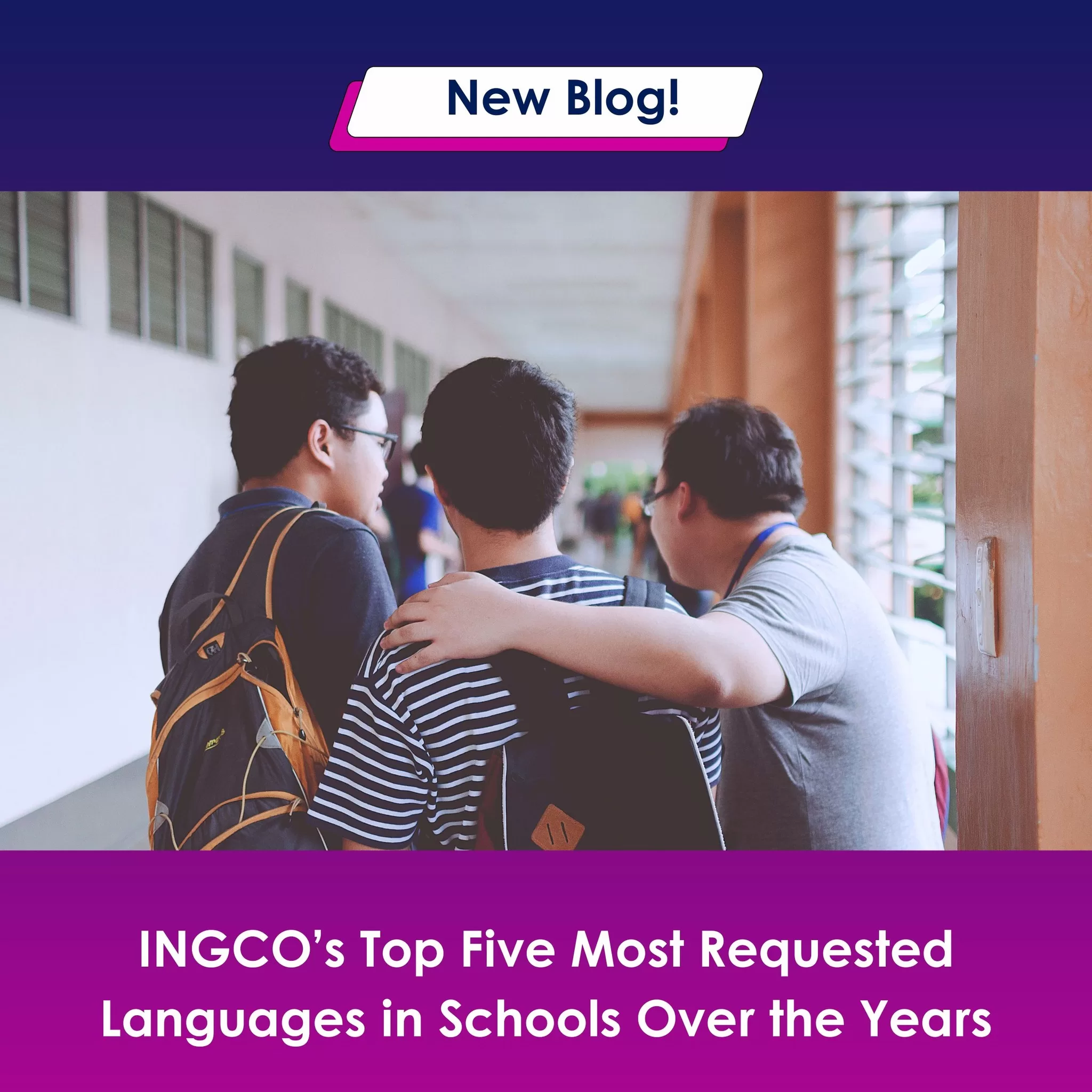
Over the years, INGCO has witnessed an increasing demand for language services in schools as the world becomes more intertwined and globalized. Our journey has led us to identify our top five most requested languages in schools through recent years, each a testament to the ever-expanding horizons of language services.
Students should not have the pressure or responsibility to interpret for their parents during school conferences. Our dedicated expertise and tailored language solutions have empowered countless students, families, and faculty members to connect effortlessly, creating stronger bonds and positive educational experiences.

Top languages of 2023
-
Spanish:
Spanish is the most widely spoken non-English language in the United States, with over 41 million native Spanish speakers and millions more bilingual speakers. The Hispanic population, which primarily uses Spanish, is the fastest-growing minority group in the US, accounting for a significant increase in Spanish speakers.
-
Somali:
The Somali-speaking community has grown substantially in the United States, mainly due to immigration and refugee resettlement programs. Major cities like Minneapolis, Minnesota, and Columbus, Ohio, have experienced significant increases in their Somali populations, leading to a rise in Somali language usage in these areas.
-
Hmong:
The Hmong community has grown steadily in the US since the first wave of Hmong refugees arrived in the 1970s after the Vietnam War. States such as California, Minnesota, Wisconsin, and North Carolina have large Hmong populations, contributing to the increased usage of the Hmong language in these regions.
-
Oromo:
Oromo is an Afroasiatic language primarily spoken in Ethiopia and parts of Kenya, but it has gained recognition in the United States due to the growing Oromo diaspora. With the increasing number of Oromo immigrants and refugees arriving in the US, there is a growing need for Oromo language services, especially in areas with significant Oromo populations, like Washington, DC, and Minnesota.
-
Swahili:
Swahili, a Bantu language widely spoken in East Africa, has grown in the United States, primarily due to immigration from East African countries such as Tanzania, Kenya, and Uganda. In major cities with large East African populations, such as Houston, Texas, and Atlanta, Georgia, Swahili language services are becoming increasingly necessary for effective integration and communication.
Top languages of 2022
-
Spanish:
Spanish remained a widely taught language in American schools due to the country’s significant Hispanic population. Schools focused on improving Spanish language proficiency to enhance communication and cultural exchange.
-
Somali:
The growing Somali-speaking population continued to drive demand for Somali language support in schools.
-
Korean:
The convergence of popular culture (such as K-pop), economic opportunities, educational initiatives, and the Korean-American community’s influence have contributed to the growing interest and demand for learning Korean.
-
Hmong:
Hmong language programs expanded further, strengthening ties with Hmong-speaking communities in the US.
-
Dari:
Dari, an official language of Afghanistan, gained prominence as more schools sought to support students from Afghan backgrounds, especially refugees and immigrants.
Top languages of 2021
-
Telugu:
Telugu, a South Indian language, garnered attention from students interested in exploring India’s linguistic and cultural diversity. Indian immigrants, including those from the Telugu-speaking regions of India, have been settling in the US for decades. As a result, there is a natural desire to preserve their linguistic and cultural heritage.
-
Arabic:
The Arabic-speaking community in the US has grown significantly, fueled by immigration from various Arab countries. As these communities establish themselves and seek to preserve their cultural heritage, the demand for Arabic language education has risen.
-
Hindi:
As more Indians immigrate to the US for education, work, and other opportunities, they bring with them their language and culture. This has led to an increased demand for Hindi language education to ensure that younger generations maintain a connection to their linguistic and cultural heritage.
-
Urdu:
The United States is home to a diverse and vibrant South Asian community, particularly from countries like Pakistan, India, and Bangladesh, where Urdu is spoken. The immigration of individuals and families from these regions has led to the establishment of communities that continue to use Urdu as a means of communication.
-
Chinese:
Chinese language learning continued to gain momentum, fueled by China’s economic influence, immigration, and practicality of Chinese language proficiency. People from China are one of the most prominent groups of immigrants in the US.
The importance of language services in education
Children shouldn’t have the responsibility of translating for their parents. Schools are obligated to offer language services to those who request them, even if a child is fluent in English and the parent is limited English proficiency.
While many students and parents can proficiently communicate in English among these languages, it is important to recognize that, under the Title VI of the Civil Rights Act, those who are not proficient in English have the right to receive translated materials and the assistance of an interpreter.
Language services enable students, faculty, and family from different linguistic backgrounds to access educational content, participate in classroom discussions, and engage in collaborative activities. Whether providing translated course materials, offering real-time interpretation during lectures, or facilitating communication between parents and teachers during conferences, translation and interpreting services ensure that language is not a hindrance to learning.
